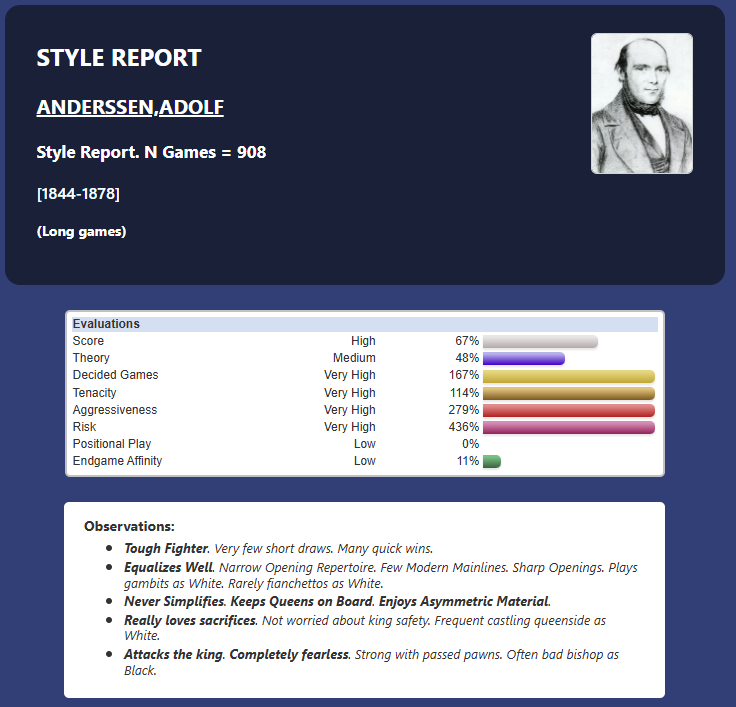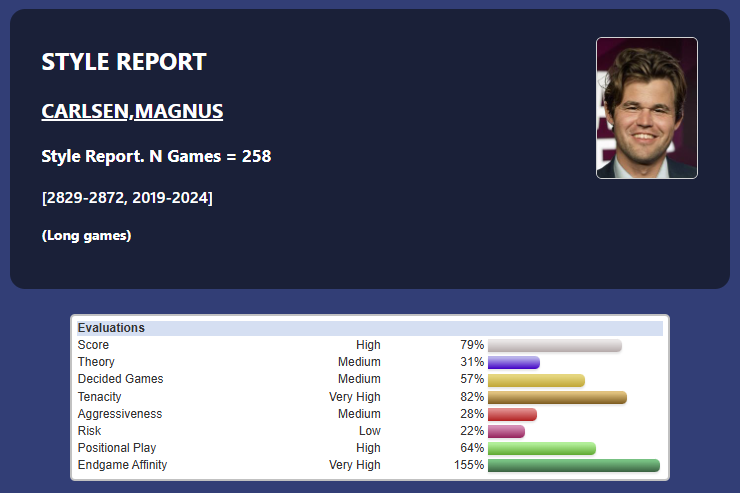.png)

.png)
How does the program arrive at these evaluations? How can it characterize a player as a positional player or an attacker? Some aspects, like results or decisive games, are based on simple counting. However, the more sophisticated evaluations analyze every position in every game considered, using statistical methods.
Tenacity is a type of psychological evaluation. Naturally, the draw rate plays a role, but more important is the frequency of short draws or, more generally, the length of drawn games. Another factor is the willingness to exchange pieces, which is an interesting metric in itself. In this context, Magnus Carlsen stands out: his willingness to exchange pieces is above average because he likes to lure opponents into the endgame. Nevertheless, he has an exceptionally high tenacity rating.
The Aggressiveness evaluation delves deeply into positional features and moves. A key parameter is the opponent's king safety, which is influenced by attacking moves. Pawn storms and the player's own king safety are also taken into account. An attacking player is willing to accept a less secure king of their own. Naturally, the willingness to sacrifice plays a significant role.

Dynamic Attacker: The young Spassky.
The manic attacking values of players from the 19th century are hardly surprising. The metrics are calibrated to modern grandmasters, where a particularly notorious attacker scores 100%.

All-out risk and always targeting the king: Adolf Anderssen
Aggressiveness and risk often correlate, but not always. The positional features used to calculate the risk value only partially overlap with those for attacking play. For example, the willingness to sacrifice is only a minor factor. Key metrics include material imbalances and asymmetric positions, as symmetric positions are considered low-risk. The player's own king safety is also significant—cautious players pay more attention to protecting their king. A dominant factor in the risk evaluation is the sharpness or complexity of the position.

High risk without permanent king attacks: Gukesh
The endgame evaluation is primarily statistical again. The overarching metric is the endgame frequency—how often does the player even make it beyond the middlegame? Then the result is factored in: is the player’s score in games with endgames higher or lower than their overall average? It gets especially interesting when a player successfully defends poor endgames (with less material), which earns many bonus points. Similarly, converting slightly advantageous endgames into wins adds to the score.
Let’s look at the superstar of endgame evaluation. Magnus Carlsen is an allround player with many nice attacking games, but the Style Report primarily characterizes him as a controlled converter of positional advantages. He also frequently avoids theoretical variations.
 Tenacity and outstanding endgame skills: Magnus Carlsen.
Tenacity and outstanding endgame skills: Magnus Carlsen.
Video about the Style Report
The Style Report is designed to avoid expensive engine calculations, which makes it quick. Additionally, it distributes tasks across nearly all the processor's cores, achieving high utilization. This approach scales well, especially when analyzing many games.

For nerds: the Style Report running with 14 parallel threads is nearly 14 times faster than on a single processor core, processing about 420 games per second. The code was parallelized from the start, as this significantly streamlines the numerous statistical experiments by making results available without delays.